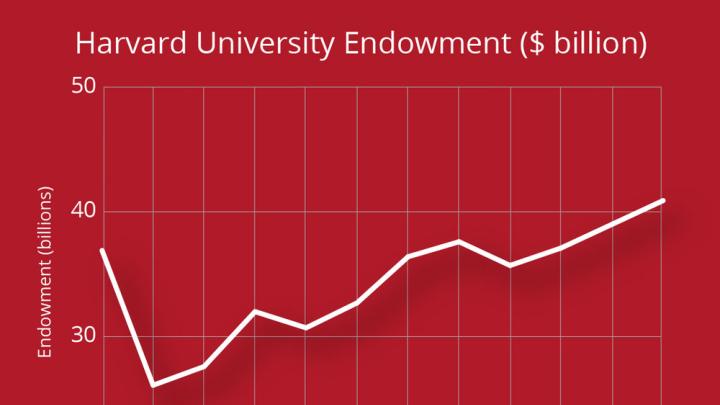Harvard management company (HMC) reported a 6.5 percent return on endowment assets for the fiscal year ended June 30, 2019. The endowment’s value on that date was $40.9 billion: up $1.7 billion (4.3 percent) from $39.2 billion a year earlier. In a year of more modest results for most university endowments (see below), HMC’s rate of return, which is net of all investment expenses, trailed the 10.0 percent it realized in fiscal 2018.
In his brief statement accompanying the announcement on September 27, N.P. Narvekar, the management company’s CEO, said, “We are now halfway through our five-year transition of both the structure of HMC and the University’s investment portfolio. I am encouraged by the progress our team has made to date, but we are mindful that there is much left to accomplish in the years ahead to resolve legacy issues and position the endowment for long-term success.”
Detailed results await publication of Harvard’s annual financial report (after this issue went to press), but Narvekar’s optimism may reflect his outlook for the HMC investments shifted from past real-estate and natural-resources holdings toward new private-equity and other assets—leavened by continued poor performance in, or further write-downs of, some of the remaining natural-resources investments such as timberlands. It was also a difficult year for investors in emerging markets. Including endowment and other assets, HMC had $4.8 billion invested in natural resources and emerging markets at the end of fiscal 2018.
Until the University issues its report, the factors contributing to the 4.3 percent rise in the endowment’s value cannot be known precisely. But a rule-of-thumb estimate suggests that beginning from the $39.2-billion value at July 1, 2018:
- the investment return during fiscal 2019 boosted the endowment by roughly $2.6 billion;
- the distribution of funds to pay for University operations (the largest source of revenue for the schools and administration, about 35 percent of income in recent years) decreased the endowment by roughly $1.9 billion; and
- gifts for endowment increased its value by perhaps $1 billion—a large sum, but plausible given pledges outstanding from The Harvard Campaign and continued, apparently robust, philanthropic support.
Compared to the very strong results in fiscal 2018, other institutions reported a much tamer performance in the most recent period. Among the perennial leaders in endowment returns, MIT earned 8.8 percent on investments in fiscal 2019 (down from 13.5 percent the prior year); the University of Virginia, 5.8 percent (vs. 11.4 percent); and Yale, which eschews nearly all stocks and bonds (strong performers during the past fiscal year), 5.7 percent (down from 12.3 percent). Stanford reported a 6.5 percent return (down from 11.3 percent).
Endowment managers and deans face two challenges in the current environment. First, for institutions like Harvard that aim to distribute investment earnings equivalent to roughly 5 percent of the market value of the endowment each year, a 5 percent to 6 percent investment return yields little, if any, net growth in the value of the underlying principal (excluding gifts received). Were such results to persist, the real value of the endowment, and thus the academic expenses it could support, would be eroded by inflation. The Higher Education Price Index for fiscal 2019 was 2.6 percent. Thus, investment returns of 6.5 percent, and distributions equal to 5 percent of market value, mean the endowment’s future purchasing power is reduced by more than 1 percent.
Second, Harvard and similar institutions therefore typically aim for long-term endowment investment returns of about 8 percent, allowing for the annual distribution and additional returns to maintain real future purchasing power. Academic plans and long-term budgets that assume such returns over time are vulnerable if they cannot be achieved sustainably. Given persistently low interest rates, some of the largest public pension funds have reduced their assumed rates of return to 7 percent or so.
Both HMC and Harvard are considering what long-term rate of return the investment managers can be expected to earn. A lower expected return would have obvious implications for the academic operations the endowment supports. For example, income derived from the endowment accounts for about half of the Faculty of Arts and Sciences’ operating funds. If Harvard’s current expected long-term endowment returns are too high, given the investment outlook (and the labor-intensive processes of teaching and research do not somehow overcome habitual inflationary pressures), the effect on a faculty like FAS from lower future distributions could be enormous.
As if these problems did not loom large enough, fiscal 2019 was the first year in which Harvard, and a few dozen well-endowed peers, incurred the federal excise tax on endowment earnings enacted in late 2017. At last estimate (not updated for U.S. Treasury guidance on how the tax will work, nor for HMC’s latest results), the University faced a tax bill of $40 million or more—effectively, a reduction in the investment returns available to distribute to the schools, at a time when realizing planned-for rates of return already appears daunting.
A detailed report on HMC’s initial announcement of results appears at harvardmag.com/endowment-19. Check back at www.harvardmagazine.com for analysis of the University’s annual financial report, expected toward the end of October.








